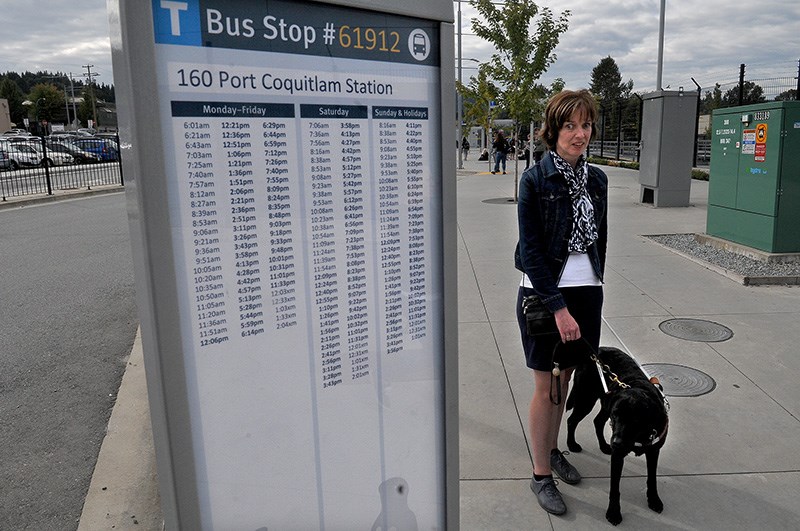To get to her home from Moody Centre station — a 15-minute bus ride — Lynn Jensen often has to ask for help from someone in Philadelphia or London.
Jensen is blind.
She relies on her guide dog, Misty, and various tactile aids like braille, raised lettering and special bumpy footpads built into the sidewalk that designate bus stops at bus loops to navigate the transit system every day to get to and from her job near the Joyce Street SkyTrain station in Vancouver.
But those aids don’t extend to the signs at bus loops that would actually tell her what bus she’s waiting for.
So Jensen fires up a special app on her iPhone, points the camera lens in the direction of what she needs to see and connects with one of 500,000 volunteers around the world who can tell her what her phone is looking at.
That’s not good enough, said Jensen, who’s brought her plight to the attention of TransLink customer service a number of times.
“I’m very independent in my commute, but this is beyond frustrating.”
Jensen said while in a perfect world every bus stop would have tactile signage, the lack of consideration for the needs of transit users with visual impairments at bus loops is particularly vexing because of the sheer number of stops and buses rolling by.
She added that those signs should have tactile versions of the same information available to sighted users, like the bay number, the bus routes that use that bay, as well as the stop’s ID number.
“This is critical information required for safe and independent travel by a person with sight loss,” Jensen said.
But a spokesperson for TransLink said it’s not as simple as providing braille versions of signage at bus stops.
Chris Bryan said the transit system needs to provide a consistent, predictable experience for all users, so braille signs would have to be installed at all of the 8,000 or so bus stops in the network.
“You don’t want to put something like that in willy-nilly,” Bryan said. “The signs are changing all the time. You need to have a machine that can make the braille and raised lettering, you need to have proofreaders who can make sure they’re correct.”
Bryan said TransLink consults regularly with a user advisory committee that includes members with disabilities like impaired vision. There’s also a station assistance program where users can call ahead to have somebody meet them at a SkyTrain station to help them navigate their way around safely.
Training for bus drivers includes instruction on how to appropriately assist people with disabilities get on and off the bus. They also put on blindfolds to experience a ride as a blind passenger so they can become familiar with how a visually-impaired user might experience transit and the cues they need to navigate it.
“We’re committed to making transit accessible for people,” Bryan said. “We need to find a solution that is more universal and that can be easily applied.”
Jensen said while she’s appreciative of TransLink’s effort to make the system accessible for everyone, it doesn’t make sense that it fall short right at a critical juncture.
“I’ve been standing at the wrong bus stop a number of times,” she said.



